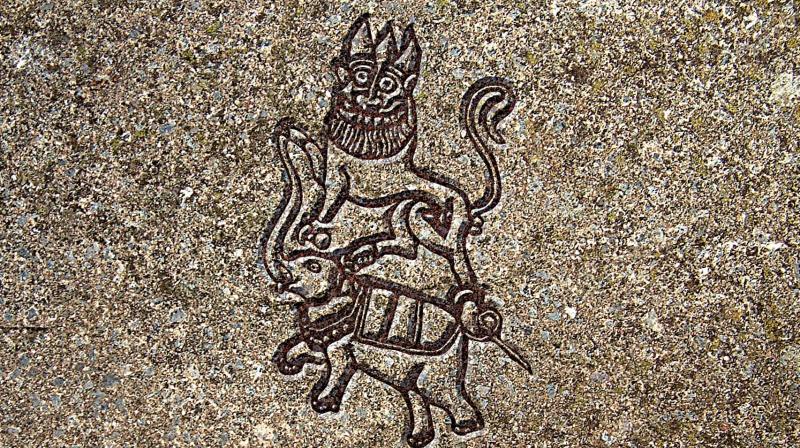Hampi: When pictures tell thousand year tales
About 30 km from Hampi is the historic village of Hale Daroji.

The twin discoveries of royal emblem of Gondwana tribal kings and pre-historic pictographs with Sindu (Harappan) script in Gondi dialect on boulders atop a hill near Taalrighatta, adjacent to the river Tungabhadra, have excited researchers as they show the world heritage site of Hampi is not only linked to the 15th century Vijayanagar Empire, but also to Dravidian tribes who may have migrated here from the Indus Valley, where civilization flourished between 2500 BC and 1750 BC.
About 30 km from Hampi is the historic village of Hale Daroji. Visitors here spy a fort on the Daroji hill. Located 674 metres above the sea level and spread across five acres, the rocky fort has become a topic of great interest to researchers as the royal emblem of the Gondwana tribal kings is found carved and filled with colour on a boulder in its grounds. Nearby are remanants of an ancient palace and ponds. Today, the area is a natural habitat for sloth bears, leopards and other wild animals protected by the Daroji Sloth Bear Sanctuary.
Venture some distance away and you see around 20 prehistoric pictographs with Sindu (Harappan) script in Gondi dialect on several rock boulders atop a hill near Taalrighatta, adjacent to the river Tungabhadra in Hampi.
The twin discoveries have excited researchers as they show that the world heritage site of Hampi is not only linked to the 15th century Vijayanagar empire, but also to Dravidian tribes that may have migrated here from the Indus Valley civilization that flourished between 2500 BC and 1750 BC.
Dr K.M. Metry, professor of tribal studies at the Kannada University, Hampi, who discovered the prehistoric pictographs, claims the script as late Harappan writing and reveals that after the collapse of the Indus valley civilisation in North-West India, the Harappans moved to other parts of the country including the Deccan.
“This discovery proves that the people of the Indus valley civilisation moved to south India after the collapse of the late Harappan stage," he says.
Mr Prakash Namdev Rao Salame, a Gondhi language expert, who visited Hampi to see the paintings for himself, was able to decipher the statement, “On the goddess Kotamma temple, woollen market way, there is a rocky roof shelter for shepherds and sheep to stay the night upto the morning” using root morphemes of the Gondi dialect, thought to be a proto Dravidian language.
Professor Metry and Mr Salame are now jointly working to discover and decipher the paintings, and carvings seen on the boulders in Hampi and Anegundi.
Gondhi research scholar, Dr Motiravana Kangale, who discovered the carving on the boulder in the Daroji hill fort says, “A raiding lion on a raiding elephant is the royal emblem of Gondi tribal kings. It was the royal emblem of Gond king, Yaduraya Madavi who ruled Gadakatanga Gond province in Jabalpur, Madhya Pradesh in AC 358".
Gondwana, he explains, is the historical name for a large tract of hilly country in India, which roughly corresponds with the greater part of the present Central provinces. It is derived from the aboriginal tribe of Gonds, who still form the largest element in the population of these provinces and at one time ruled them.
The scholars are, however, concerned about the stone quarrying, both licensed and illegal in the rocky terrains of Hampi, posing a serious threat to the Harappan paintings.
“The Archaeological Survey of India should immediately take action to stop quarrying here and create awareness about the historical value of these paintings among the villagers. They should be trained to protect these sites,” said Mr Salame at a seminar on the paintings at the Hampi Kannada University.
Other historians also deplore that the remanants of the stone age civilisation found in Hampi area are receiving scant attention from the Archaeological Survey of India, which has not bothered to notify the area or taken any steps to protect it.

